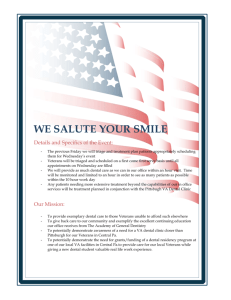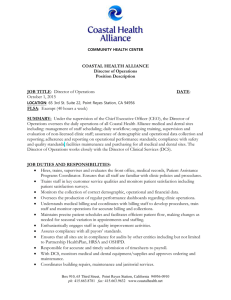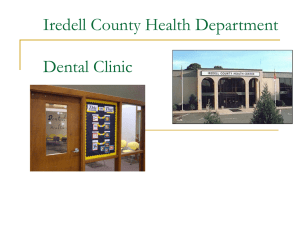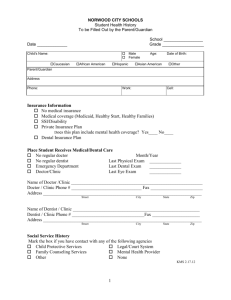Section_IV_clinical_.. - Canadian National Institute of Health
advertisement
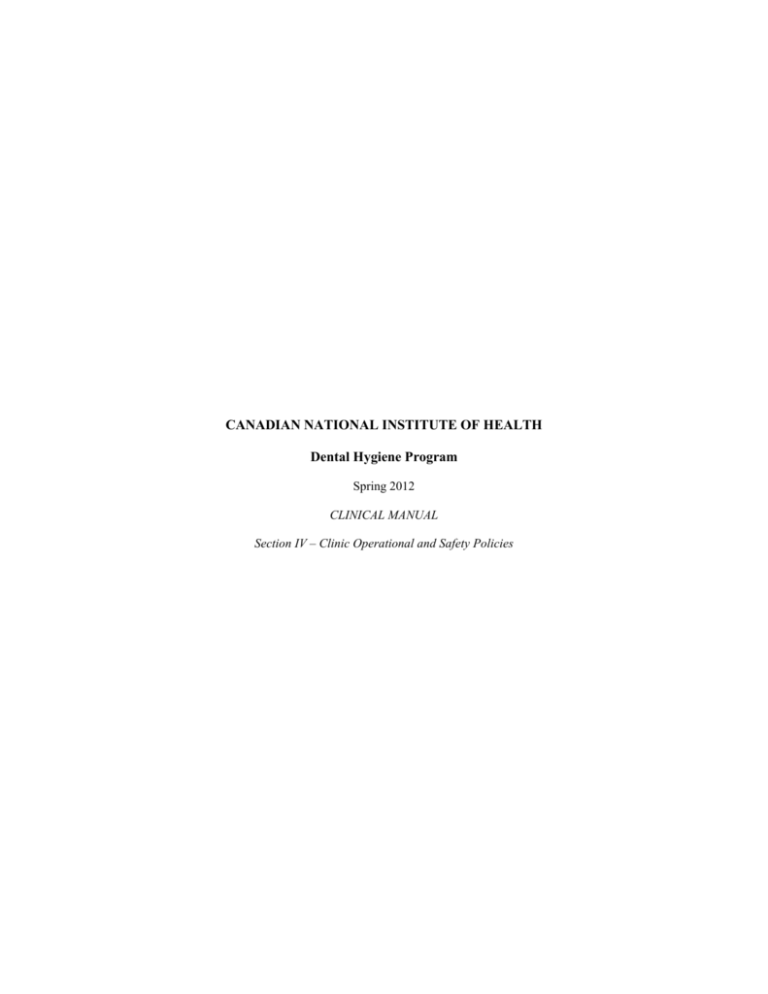
CANADIAN NATIONAL INSTITUTE OF HEALTH Dental Hygiene Program Spring 2012 CLINICAL MANUAL Section IV – Clinic Operational and Safety Policies CNIH - Dental Hygiene Program2012 Revised March 2012 Table of Contents Infection Control Procedures Correct Use of Personal Protective Devices 3 Cleanliness of Client Clinical and Student Assessment Documents 4 Handling of Pathogenic Waste 5 Treatment Unit and Client Preparation for Treatment 6 Post-treatment Sanitation of Treatment Unit, Equipment and Instruments 6 Processing Hand Instruments 8 Sterilization of School Instruments 8 Sanitation in the Radiography Area 8 Care of the Dental Laboratory and Equipment 10 Safety Policies General Guidelines for Safety in the Dental Clinic 12 Emergency Protocol – Fire 13 Emergency Protocol – Medical 14 Locations of medical and emergency equipment Steps in handling a medical emergency 15 15 Responsibilities of the Duty Student Reception Dispensing/Sterilization Area Radiography Area Case Degree of Difficulty Designation 16 17 17 19 Clinical Manual, Section IV – Clinic Operational and Safety Policies 2 CNIH - Dental Hygiene Program2012 Revised March 2012 CLINIC OPERATIONAL AND SAFETY POLICIES INFECTION CONTROL PROCEDURES Correct Use of Personal Protective Devices Clean clinical clothing is required for each clinical session. (see Section II of this manual for dress code). Non-vinyl operating gloves, face masks and protective eye wear are required when providing client services that pose a risk of cross infection between client and operator. Students are required to wear radiation dosimeter badges while working in the dental clinic and radiography area. These are the property of the Institute and are on loan to students while they are in the program. Students who lose or damage a badge will be required to pay for a replacement. Students will pick up their badges from the storage rack in the dental clinic at the beginning of a session and return them to the rack when leaving the area at the end of the clinic. Healthy, intact skin is your natural barrier to infection. With frequent hand washing, maintaining healthy skin is a challenge. Using the following technique will help: Use lukewarm water. Wet hands and wrists, keeping hands lower to control water flow. Avoid splashing water on clothing. Apply germicidal soap and lather all parts of the hands thoroughly. Use a brush to clean under fingernails if necessary. Rinse hands well. Dry hands well with paper towels. If taps are manually operated, turn them off using your elbows if possible or a paper towel so that hands do not become contaminated. Use skin conditioners and moisturizers frequently. If skin becomes irritated to the point of increased risk for operator infection (i.e., weeping dermatitis or open sores) consult your supervising clinician for advice on required procedures. Clinical Manual, Section IV – Clinic Operational and Safety Policies 3 CNIH - Dental Hygiene Program2012 Revised March 2012 Operating Gloves Face Masks and Protective Eye Wear Operating gloves are required when performing client services that involve possible contact with the client’s body fluids. Clean over gloves are used to cover contaminated operating gloves when: – – – handling the client’s files during a treatment appointment. accessing supplies in the treatment area. leaving the treatment unit to access supplies or to sign for a supervising clinician to come to your unit. Treatment gloves are NEVER used for treatment of more than one client. Change treatment gloves during client care if they change colours or if they tear. When removing gloves for disposal: – – – wash them first. take care not to touch your skin with the contaminated surface of the glove. grasp the glove at the wrist and strip it off the hand so that it turns inside out. Wash hands thoroughly. Masks must be clean for each client. They are replaced during care of that client when they become damp or visibly soiled. Do NOT touch them while in use. Remove masks completely when not in use (do NOT wear them around your neck). Remove masks by grasping the strings being careful not to touch the mask or your hair. Protective eye wear should be disinfected between clients or when visibly soiled. All clients should be provided with safety glasses provided by the school these are to be disinfected after each use. Cleanliness of Client Clinical and Student Assessment Records All clinical documents pertaining to client care or student performance must be handled in a manner that keeps them clean. All such documents are to be handled with clean bare hands OR if necessary during the course of client treatment, with clean over gloves covering soiled operating gloves. Place client chart on top of mobile or stored in chart holder. Keep counter space free to allow for maximum working space. Clinical Manual, Section IV – Clinic Operational and Safety Policies 4 CNIH - Dental Hygiene Program2012 Revised March 2012 Handling of Pathogenic Waste Any item used in the delivery of treatment that has the capacity to pass infection on to someone else (client or operator) is referred to as a biohazard or considered to be pathogenic. Many diseases such as herpes, hepatitis, HIV etc. are spread by means of viruses or bacteria living in blood or tissue fluids. Any instrument or disposable item which, during the course of treatment, becomes saturated with blood or tissue fluid becomes pathogenic. In the dental clinic items that can carry infection include; saliva ejector tips, gauze squares, soiled dental floss, rubber polishing cups and brushes, cotton rolls etc. These are items that must be handled according to their potential to pass on infection. Biohazardous waste is identified as blood soaked gauze squares or other absorbent material from which droplets of blood can be squeezed out. Biohazardous waste is disposed of in the biohazard waste bags in the treatment units. During clinical sessions involving client treatment, please handle waste products according to the information in the table below: Biohazardous or Pathogenic Waste Blood soaked gauze wipes and cotton rolls Other Waste Materials These materials can be placed in regular garbage containers. Paper products (head rest and tray covers, paper cups, glove boxes, towels from hand washing and unit disinfection) Masks Disposable air/water syringe tips Used over gloves Barrier film from equipment Operating gloves (wash hands with soap and hot water before removing gloves: strip off hands to turn them inside out before discarding). Revised March 3, 2010 Clinical Manual, Section IV – Clinic Operational and Safety Policies 5 CNIH - Dental Hygiene Program2012 Revised March 2012 Treatment Unit and Client Preparation for Treatment Place foot control for handpiece on the floor. Wash hands. Place full distilled water bottle on unit, turn on master switches and lower chair. Wash and dry hands thoroughly. Obtain instruments/materials from the dispensing station. Insert air/water syringe tip and saliva ejector tip and place the appropriate barrier film. Flush air/water syringe (and handpiece if applicable) lines for 30 seconds. Place protective barriers on dental chair, bracket table, hoses, prophy angle, light handles and ultrasonic scaling unit (if to be used). Flush line from unit for 2 minutes. Set out sealed instrument cassette on bracket table. Verify Chemical indicator (tape or sterilization bag) Cover bracket table with clean disposable client bib. Sort material from client’s file (charts, x-rays etc.) as needed. Set out operating gloves, over gloves, mask, protective eye wear for operator and client. Greet and seat client. Place bib, safety glasses and provide antimicrobial mouth rinse. Record client’s updated medical history. Check and record client’s vital signs if indicated. Put on mask, safety eyewear and operating gloves. Open instrument cassette. Post-treatment Sanitation of the Treatment Unit, Equipment and Instruments When performing all sanitation procedures wear heavy gauge utility gloves, mask and safety glasses. Wash operating gloves, strip off to turn inside out and discard with normal garbage. Wash hands and put on utility gloves Dispose of used needles in the sharps container. When ¾ full, transport to the decontamination area for appropriate disposal. Revised December 11, 2009 Clinical Manual, Section IV – Clinic Operational and Safety Policies 6 CNIH - Dental Hygiene Program2012 Revised March 2012 Dispose of biohazardous waste. Place contaminated disposable equipment and supplies that are not defined as biohazardous (i.e., barrier film, tray covers etc.) in the soiled headrest cover and dispose in regular garbage receptacle. Assemble cleaning supplies (disinfectant, wipes, cleaning brush, HVE solution). Disassemble handpiece, use scrub brush to remove debris, lubricate all parts, reassemble, purge for 30 seconds, bag and label (name, date and clinic session number) for sterilization. Ultrasonic inserts and prophy jet tips are rinsed, dried and bagged for sterilization. Examine instruments for debris and rinse off, use hand brush if needed. Load hand instruments into cassette and take to decontamination area for processing. Disinfect and store client safety glasses. Remove the strainer from the cuspidor, rinse thoroughly, wrap with disinfectant wipes and place in the sink. Place 60 ml. (1/4 cup) of disinfectant solution in the cuspidor drain and run water through it for several seconds. Run the remainder of the solution through the suction lines (saliva ejector and HVE). Disinfect solution container before returning to storage. Bleed unit water lines for 30 secs. Using disinfectant wipes (a new one for each step) clean the equipment as follows: Wipe the light switch, handle and face (NOT the back), cup filler and switches on the cuspidor outside of the cuspidor. Wipe chair adjustment and bracket table switches, bracket table and supporting arm, adjustment levers of the operator’s stool, back of the dental chair and operator’s stool (NOT the leather parts) Wipe all dental line tubing. (A/W line, hand piece, suction) Wipe the drawer and cupboard door handles, counter top, soap dispenser and inside of the cuspidor Using leather cleaner, wipe down the dental chair and operator’s stool. When light has cooled, clean back with wet paper towel. Return strainer to the cuspidor. Remove safety glasses and disinfect. Sanitize the sink, scrub brush, disinfectant bottle and utility gloves. Dry gloves and store cleaning equipment and supplies. Clinical Manual, Section IV – Clinic Operational and Safety Policies 7 CNIH - Dental Hygiene Program2012 Revised March 2012 Remove and discard mask. Wash hands. Processing Hand Instruments While processing hand instruments, wear heavy gauge utility gloves Each cassette is placed in the instrument washer. When complete, the cassette is removed and instruments checked for visible debris. If not clean, they are recycled until they pass inspection. An indicator strip is placed in each cassette and the cassette is wrapped and labelled with the student’s name, date and clinic session number. Wrapped, labelled cassettes are placed into the sterilizer. Each load sterilized is logged. Sterilized cassettes are moved to storage. Sterilization of School Instruments Examine instruments for debris, rinse off, use hand brush if needed. Identify as school equipment and return to processing area for sterilization and storage. Sanitation in the Radiography Area BEFORE SEATING THE CLIENT With over gloves on complete the following: Collect the appropriate number of radiographs from the storage area. Clinical Manual, Section IV – Clinic Operational and Safety Policies 8 CNIH - Dental Hygiene Program2012 Revised March 2012 If the film is not pre-barriered, place it in a barrier envelope. Place the prepared films on a clean paper towel outside the x-ray room. Place a clean paper cup beside the towel. Choose and assemble any film holding devices that you are planning to use. Turn on the x-ray machine and select settings as required Place plastic barrier wrap on the following: The time selection and exposure switches on the x-ray machine control panel. Chair head rest, control switches and door knob. SEAT THE CLIENT AND PLACE THE LEAD APRON Remove over gloves and dispose, expose the prescribed films. After each exposure, open the barrier and let the film drop into the clean paper cup. Place the soiled barrier film and used holders on the paper towel. Be careful not to touch the cup or the unbarriered films with your soiled gloves. When all exposed films have been deposited in the cup, gather the soiled barriers in the paper towel and place in the waste container. Remove gloves and wash your hands DISMISS THE CLIENT FROM THE RADIOGRAPHY AREA. With clean bare hands, prepare and process the films: Label a film packet with your name and the number and type of views taken in your series to track the films in the processor. Record the number and type of views exposed on the quality control sheet posted near the processor. Choose and label (in pencil) a mount appropriate for the views. Include: client’s full name; date of exposure; prescribing dentist’s name; your initial, surname and clinic unit number and number of radiographs exposed. Insert the films into the processor. While films are developing, disinfect radiography room. Clinical Manual, Section IV – Clinic Operational and Safety Policies 9 CNIH - Dental Hygiene Program2012 Revised March 2012 Disinfect the x-ray room: Wear utility gloves. Remove contaminated barriers from equipment and discard. Bag and label used film holding devices and return to the decontamination area for sterilization. Disinfect, dry and store utility gloves. When the room is clean, turn off the light: place “sterilized “ tag on outside door knob. Retrieve your processed radiographs. Insert the radiographs in the labelled mount. Ensure that the radiographs become part of the client’s clinical records. Care of the Dental Laboratory and Equipment Impressions and Impression Trays When an impression is removed from the mouth, rinse it immediately with water to remove saliva and any blood visible. Spray the impression with a disinfectant approved by the manufacturer of the impression material and wrap it in a paper towel wet with the same disinfectant solution. Leave until ready to pour (at least 15 minutes). Unwrap the impression, rinse with water and shake excess from the surface. Bag and transport to the dental lab for pouring. When the impression tray is removed from the model, remove all traces of impression material and utility wax from the tray and discard the material in the garbage. Ensure that material remnants are not flushed into sink traps. Prepare the trays for sterilization: rinse, dry, bag, identify and transport to the appropriate area. Clinical Manual, Section IV – Clinic Operational and Safety Policies 10 CNIH - Dental Hygiene Program2012 Revised March 2012 Rubber Bowls and Spatulas Scrape excess plaster from bowls before it sets and discard with garbage. DO NOT let set or un-set plaster enter the sink drains. Remove plaster from spatulas immediately after use. Ensure that the handle, sides and edges of the blade are clean. Protect the blade from scratches. Note: Spatulas used for client care must be sterilized and the rubber bowls sanitized with hard surface disinfectant. Model Trimmers NEVER wear hand jewellery while operating a model trimmer as it can become caught in the wheel. Ensure that there is adequate water flow to the grinding wheel at all times during use. Clean residue from the wheel by holding the brush carefully against the wheel while it is in motion. Turn off the machine and wipe residue from the platform. Clean up spills on the counter or floor. Vibrators and Moulds Remove gypsum residue after use. Wipe clean and dry. Mouth Guard Forming Equipment Use and maintain only under the supervision of a staff member. Clinical Manual, Section IV – Clinic Operational and Safety Policies 11 CNIH - Dental Hygiene Program2012 Revised March 2012 SAFETY POLICIES General Guidelines for Safety in the Dental Clinic Keep personal belongings (students’ and clients’) in the treatment area to a minimum, off the floor and out of traffic areas. Floors are slippery when wet. Wipe up any spilled liquids immediately. Always use the dental unit in a configuration that maintains its stability. Wide extension of the bracket table can disrupt the unit’s balance. When seating and dismissing the client make sure that all equipment is out of the client’s path to and from the dental chair. Never place equipment so that it poses a risk to the clients, operators or others. Never place instruments or equipment on the client’s chest or lap. This is a CDHO standard of practice. Never pass instruments over the client’s face. Never adjust the operating light with instruments in that hand. Never leave young children alone in the treatment unit. If you must leave, ask a student in the adjacent unit to watch your child client. If you or your client sustains an injury during a clinical session, report it immediately to the supervising clinician for appropriate handling and reporting. If you sustain a cut or puncture wound with a contaminated instrument do the following: - remove your gloves encourage bleeding at the site wash hands thoroughly with soap and water apply antibacterial preparations or alcohol to the site report to your supervising clinician for advice on further action. Clinical Manual, Section IV – Clinic Operational and Safety Policies 12 CNIH - Dental Hygiene Program2012 Revised March 2012 Emergency Protocol – Fire General principles: Act quickly and quietly to avoid initiating panic in others. Do NOT use elevators. Do NOT stop to collect personal belongings. Leave the building by the nearest safe exit. Call the 911 emergency number from outside the building. Provide as much information as possible to the operator. Stay on the line until advised to hang up. Move at least 100 meters away from the building. Remain outside the building until advised by the emergency response personnel that it is safe to reenter. If you discover the fire: Close the door on your way out. Activate the nearest fire alarm and leave the building immediately. If you hear the fire alarm: Close the door on your way out and leave the building immediately. If you are providing a service to clients and hear the alarm: Stop work immediately. Accompany your client and leave the building immediately using the nearest exit. If you are in charge of the class or activity: Stop all activity. Designate a meeting point outside the building. Ensure that all persons involved leave the building immediately by the closest safe exit. Clinical Manual, Section IV – Clinic Operational and Safety Policies 13 CNIH - Dental Hygiene Program2012 Revised March 2012 Close all doors on the way out. At the meeting point, ensure that all persons involved in the activity are accounted for. If persons are suspected of being inside, advise emergency response personnel of this possibility. Emergency Protocol – Medical Aspects of Emergency Response Where possible, advance preparation should be used to reduce the potential for occurrence of a medical emergency during dental treatment. Recording an accurate health history for each client and identifying those at potential risk is part of a successful medical emergency prevention plan. The second aspect of emergency response is to know the location of life support equipment and materials and how to proceed when an emergency does occur. Some positive responses to health history questions may indicate that it is not in the client’s best interest to be treated in the school dental clinic. Discuss such findings with the duty dentist. S/he will verify if this is the case and advise the client to contact a facility that can meet his/her special treatment needs. Even though appropriate precautions are in place, medical emergencies do happen. That is why students are required to maintain current certification in first aid and C.P.R while providing client care at the Institute. These qualifications are also part of the CDHO standards of practice for registered dental hygienists. An effective emergency response system includes: Ready access to a telephone to summon outside help. Readily available emergency equipment and supplies. Staff and students who know how to act efficiently during a medical emergency Clinical Manual, Section IV – Clinic Operational and Safety Policies 14 CNIH - Dental Hygiene Program2012 Revised March 2012 The school medical emergency equipment is located as follows: Equipment Clinic Location Telephone Front of clinic; Dispensing area; Client reception area Portable oxygen tank Front of clinic Stethoscopes and blood pressure cuffs Front of clinic in labelled cupboards Emergency kit and drug box Shelf unit in front of clinic by window Juice boxes Dispensing station fridge Eye wash station Front of clinic Steps in Handling a Medical Emergency If your client experiences a medical emergency during an appointment do not leave him or her alone at any point. Remain clam and proceed quickly and quietly as indicated below. Ask a classmate in an adjacent treatment unit to remain with your client. Approach the duty dentist or supervising dental hygienist immediately and report the type of emergency your client is experiencing. Accompany them to your treatment unit. The staff will now direct your assistance in handling the emergency. If internal assistance is available, call and request it. If external assistance is required call 911 and advise the response team of the easiest access route to the client. When the calls are completed, advise the staff that help is on the way. Take a copy of the emergency report form to the staff dealing with the client so that information on actions already taken can be transported with the client. Meet the emergency response team at the building entry you specified for appropriate access and lead the team to the client requiring assistance. Clinical Manual, Section IV – Clinic Operational and Safety Policies 15 CNIH - Dental Hygiene Program2012 Revised March 2012 Responsibilities of the Duty Student During the program, students will be assigned to assist in clinical operations for a small number of clinical sessions. This provides students with an opportunity to experience more closely, the roles of other members of the dental team and to learn support skills useful in employment situations. Duty students will be assigned to the following areas: client reception; dispensing/sterilization stations; radiography area. All clinical attendance and dress requirements apply when on assignment as a duty student. Duty students are required to report to their assigned areas 15 minutes prior to the beginning of the clinical session. Students must document activities accomplished while on duty and have their participation verified by the staff supervisor for the assignment. Reception Duty When assigned to clinic reception duty students are required to: Report to the Clinic Receptionist. Provide clients appointed for the first time with blank charts to complete personal and health histories. Receive payments for services from clients and issue receipts. Greet drop-in clients and appoint immediately as a new client if a student during that clinical session has had a last minute cancellation. If service cannot be provided immediately, take necessary contact information and give it to the receptionist for inclusion in the client data base. Meet clients requesting emergency care, determine their needs and consult with an appropriate staff member regarding further service provision. File client charts from previous clinical session. Pull charts for the next clinical session. Confirm client appointments. Assist with other duties as assigned and monitored by the clinic receptionist. Clinical Manual, Section IV – Clinic Operational and Safety Policies 16 CNIH - Dental Hygiene Program2012 Revised March 2012 Dispensing/Sterilization Area When assigned to dispensing/sterilization duty students are required to: Assist in maintaining cleanliness/asepsis and organization in the dispensing and sterilizing areas. Dispense properly requisitioned equipment and supplies. Learn and complete (under supervision) routine maintenance of equipment in the areas if due. Stock clinical boxes with consumable supplies as required. Complete the decontamination and sterilizing cycles for incoming instruments. Maintain sterilization and spore testing logs. Assist with other duties as assigned and monitored by the staff member in the dispensing area. Radiography Area When assigned to radiography duty students are required to: Turn on the processor and ensure it is working properly. Top up the processing solutions as appropriate. Check processor solution temperature for accuracy. Carry out routine processor maintenance (under supervision) if due. Expose and process test films for each x-ray machine to ensure proper function. Advise a staff member immediately if machine malfunction is suspected. Stock all radiography rooms with consumable supplies as appropriate (barriers, paper towels, facial tissues etc.) Monitor asepsis during exposure of radiographs. Assist with developing exposed films. Maintain the exposure log. At the end of the session, return processor to “stand-by” status if another clinical session follows. If the last clinic of the day, turn off and vent processor. Clinical Manual, Section IV – Clinic Operational and Safety Policies 17 CNIH - Dental Hygiene Program2012 Revised March 2012 Ensure that all the x-ray machines have been returned to an acceptable configuration and power switches turned off. Ensure that all radiography rooms, dark room and viewing area are disinfected at the end of the session. Assist with other duties as assigned and monitored by a supervising clinician. Clinical Manual, Section IV – Clinic Operational and Safety Policies 18 CNIH - Dental Hygiene Program2012 Revised March 2012 CASE DEGREE OF DIFFICULTY DESIGNATIONS Criteria Degree of Difficulty DD0 DD1 DD2 Plaque and Extrinsic Stain Stain: none Plaque: minimal Stain: light minimal Plaque: localized scanty Stain: light to moderate Plaque: generalized scanty Supragingival Deposits: localized scanty Deposits: generalized light Localized light to moderate Subgingival Deposits: none or very minimal Deposits: generalized scanty to light or localized to salivary duct areas Deposits: localized scanty Perio Status Sulcus depth between 1-3mm No bleeding present upon instrumentation Additional intra oral considerations No access limitations Normal tooth position Number of teeth present Generalized sulcus depth between 1 – 3mm Localized 4mm pockets Localized bleeding upon instrumentation No access limitations Normal to slight variation in tooth position Number of teeth present Client Related considerations * Cooperative No specific considerations Cooperative Possible client considerations Total required appointments (suggested guidelines only) Instructor Assistance level Term 2 – 1 Term 3 – ½ to 1 Minimal DD3 DD4 Stain: light to moderate Plaque: generalized light to moderate Deposits: localized or generalized moderate Stain: moderate to heavy Plaque: generalized light to moderate Deposits: generalized light Deposits: generalized moderate Generalized sulcus depth between 1 – 3mm Localized 4 – 5mm pockets Localized bleeding upon instrumentation Generalized 4 – 5 mm pockets Generalized bleeding upon instrumentation Deposits: generalized moderate to heavy Generalized 5mm and greater pocket depths Generalized bleeding upon instrumentation Some challenges due tooth positioning, limited opening, restorations, missing teeth, third molars, musculature, tooth sensitivity, recession, furcation involvement Number of teeth present Possible client considerations Some challenges due tooth positioning, limited opening, restorations, missing teeth, third molars, musculature, tooth sensitivity, recession, furcation involvement, tenacious hard deposits Number of teeth present Possible client considerations Some challenges due tooth positioning, mobility, limited opening, restorations, missing teeth, third molars, musculature, tooth sensitivity, recession, furcation involvement, tenacious hard deposits Number of teeth present Possible client considerations Term 2 – 1 to 2 Term 3 - 1 Term 2 – 2 to 3 Term 3 – 1 ½ to 2 Term 2 – 3 to 4 Term 3 – 2 to 3 Term 2 – 5 to 7 Term 3 – 4 to 6 Minimal Minimal to moderate Moderate Extensive Deposits: localized or generalized moderate to heavy Clinical Manual, Section IV – Clinic Operational and Safety Policies 19 CNIH - Dental Hygiene Program2012 Revised March 2012 Instructor Assistance level with Case Presentation Term 2 and 3: minimal clarification Term 2 and 3: minimal clarification Term 2 and 3: minimal clarification Term 2 and 3: minimal to moderate clarification Term 2 and 3: minimal to moderate clarification *Client Related Consideration: Client’s human needs deficits must be taken into consideration when determining the degree of difficulty in regards to treatment planning. Assess and reflect on the human needs deficits that apply to the client when assessing the degree of difficulty. Examples of considerations include: General health, side effects of medications, client’s age, physical and emotional needs, positioning, cooperation, language, sensitivity, required breaks, strong gag reflex, amount of bleeding and saliva, oral habits, and psychosociocultural needs. The list is not exhaustive. In each designation subgingival deposits must be present: all other criteria may possible be present. “Our mission is to provide quality education to dental hygiene students through dental hygiene theory and practice, comprehensive oral health care to the community and to promote individual growth and development through life-long learning” Clinical Manual, Section IV – Clinic Operational and Safety Policies 20

